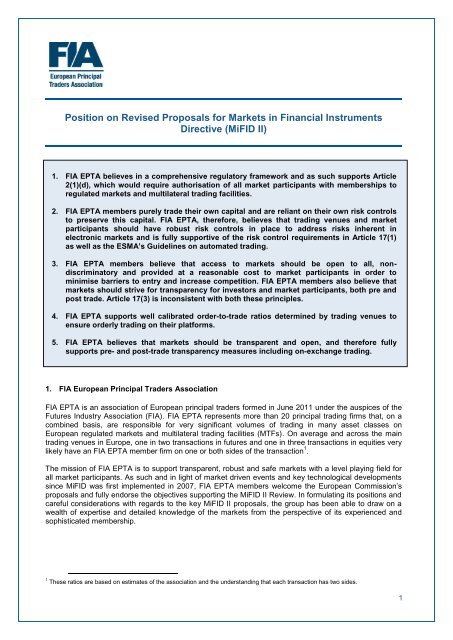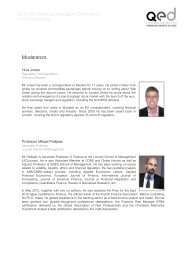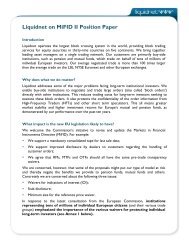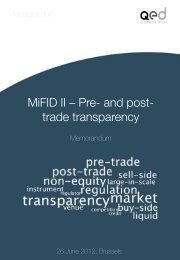FIA EPTA's position paper - Futures Industry Association
FIA EPTA's position paper - Futures Industry Association
FIA EPTA's position paper - Futures Industry Association
Create successful ePaper yourself
Turn your PDF publications into a flip-book with our unique Google optimized e-Paper software.
Position on Revised Proposals for Markets in Financial Instruments<br />
Directive (MiFID II)<br />
1. <strong>FIA</strong> EPTA believes in a comprehensive regulatory framework and as such supports Article<br />
2(1)(d), which would require authorisation of all market participants with memberships to<br />
regulated markets and multilateral trading facilities.<br />
2. <strong>FIA</strong> EPTA members purely trade their own capital and are reliant on their own risk controls<br />
to preserve this capital. <strong>FIA</strong> EPTA, therefore, believes that trading venues and market<br />
participants should have robust risk controls in place to address risks inherent in<br />
electronic markets and is fully supportive of the risk control requirements in Article 17(1)<br />
as well as the ESMA’s Guidelines on automated trading.<br />
<strong>FIA</strong><br />
3. <strong>FIA</strong> EPTA members believe that access to markets should be open to all, nondiscriminatory<br />
and provided at a reasonable cost to market participants in order to<br />
minimise barriers to entry and increase competition. <strong>FIA</strong> EPTA members also believe that<br />
markets should strive for transparency for investors and market participants, both pre and<br />
post trade. Article 17(3) is inconsistent with both these principles.<br />
4. <strong>FIA</strong> EPTA supports well calibrated order-to-trade ratios determined by trading venues to<br />
ensure orderly trading on their platforms.<br />
5. <strong>FIA</strong> EPTA believes that markets should be transparent and open, and therefore fully<br />
supports pre- and post-trade transparency measures including on-exchange trading.<br />
1. <strong>FIA</strong> European Principal Traders <strong>Association</strong><br />
<strong>FIA</strong> EPTA is an association of European principal traders formed in June 2011 under the auspices of the<br />
<strong>Futures</strong> <strong>Industry</strong> <strong>Association</strong> (<strong>FIA</strong>). <strong>FIA</strong> EPTA represents more than 20 principal trading firms that, on a<br />
combined basis, are responsible for very significant volumes of trading in many asset classes on<br />
European regulated markets and multilateral trading facilities (MTFs). On average and across the main<br />
trading venues in Europe, one in two transactions in futures and one in three transactions in equities very<br />
likely have an <strong>FIA</strong> EPTA member firm on one or both sides of the transaction 1 .<br />
The mission of <strong>FIA</strong> EPTA is to support transparent, robust and safe markets with a level playing field for<br />
all market participants. As such and in light of market driven events and key technological developments<br />
since MiFID was first implemented in 2007, <strong>FIA</strong> EPTA members welcome the European Commission‟s<br />
proposals and fully endorse the objectives supporting the MiFID II Review. In formulating its <strong>position</strong>s and<br />
careful considerations with regards to the key MiFID II proposals, the group has been able to draw on a<br />
wealth of expertise and detailed knowledge of the markets from the perspective of its experienced and<br />
sophisticated membership.<br />
1 These ratios are based on estimates of the association and the understanding that each transaction has two sides.<br />
1
2. Guiding Principles for the MiFID II Review<br />
We believe that the revised MiFID regulatory environment with respect to financial markets and the<br />
trading in financial instruments should focus on:<br />
• Regulating all direct market participants. <strong>FIA</strong> EPTA believes that any market participant in Europe<br />
with direct access to markets should be authorised by a competent authority. In this respect, we are<br />
strongly supportive of the provisions as contained in article Article 2(1)(d);<br />
• Promoting responsible risk management. <strong>FIA</strong> EPTA believes that exchanges and market<br />
participants should have safeguards in place for managing the various risks inherent in electronic<br />
markets. To this effect, <strong>FIA</strong> PTG (<strong>FIA</strong> EPTA‟s sister organisation) has published a set of<br />
recommendations on implementing risk controls for trading firms; 2<br />
• Supporting resiliency and safety of financial markets. Market participants and exchanges need to<br />
implement stringent controls and procedures to ensure that systems are robust. To this effect, <strong>FIA</strong><br />
EPTA has issued a set of recommendations for software development and change management. 3<br />
WHILST extending the substantial gains that have accrued to investors from automation and competition:<br />
• Lower trading costs. Research shows that trading costs since the introduction of MiFID have fallen<br />
by between 21% and 30%; 4<br />
• Reduced bid-ask spreads. Research shows that bid-ask spreads have declined by almost 30%<br />
since 2005; 5 and<br />
• Greater liquidity. 6 Research shows that the available liquidity in the European order books has<br />
improved considerably since 2006, prior to the adoption of MiFID.<br />
3. <strong>FIA</strong> EPTA <strong>position</strong> on key provisions in MiFID II Proposal<br />
Detailed remarks by issue:<br />
(a) Comprehensive regulatory framework: Article 2(1)(d)<br />
The members of <strong>FIA</strong> EPTA are committed to a sound regulatory framework. We believe that all firms who<br />
are members of a trading venue should require authorisation. As such, the members of <strong>FIA</strong> EPTA<br />
strongly support the proposed amendment to extend the scope of the MiFID regime to capture principal<br />
traders engaged in market-making activities or are members of a regulated market or MTF.<br />
(b) Definition of algorithmic trading: Article 4(30)<br />
<strong>FIA</strong> EPTA believes that the Article 4(30) definition of “algorithmic trading” is appropriate and workable.<br />
<strong>FIA</strong> EPTA believes too much commentary and media reporting has focused on supposed „high-frequency<br />
trading strategies‟. High-frequency trading is simply a new means, or tool, used to implement age-old<br />
trading strategies such as arbitrage and market-making. As principal traders, <strong>FIA</strong> EPTA members engage<br />
in a wide range of these trading strategies.<br />
We note that our <strong>position</strong> is in line with the conclusions reached by ESMA‟s Task Force established in<br />
February 2011 to consider micro-structural issues in an automated trading environment and which<br />
resulted in the publication in December 2011 of Guidelines on systems and controls in an automated<br />
trading environment for trading platforms, investment firms and competent authorities 7 . See also below<br />
under section 5 (Risk Management).<br />
2 Reports available on <strong>FIA</strong> EPTA‟s website [http://www.futuresindustry.org/epta/].<br />
3 Reports available on <strong>FIA</strong> EPTA‟s website. [see in particular:<br />
http://www.futuresindustry.org/downloads/Software_Change_Management.pdf].<br />
4 Oxera.<br />
5 Measured by the cost of executing 25,000 Euros in the main European Index names from the midpoint.<br />
6 Measured by the cost of executing 500,000 Euros in the main European Index names from the midpoint. The data show that in<br />
2005 the average execution price was 69 basis points, in 2011 it was 35 basis points.<br />
2
(c) Participants‟ obligations to the marketplace: Article 17(3)<br />
<strong>FIA</strong> EPTA members believe that access to markets should be open to all, non-discriminatory and<br />
provided at a reasonable cost to market participants in order to minimise barriers to entry and increase<br />
competition. Our members also believe that markets should strive for transparency for investors and<br />
market participants, both pre and post trade. Article 17(3) is inconsistent with both these principles.<br />
Article 17(3) proposes to require a subset of firms to post firm quotes at competitive prices with the result<br />
of providing liquidity on a regular and ongoing basis to trading venues at all times, regardless of prevailing<br />
market conditions. To impose quoting obligations on a subset of firms in any piece of legislation is, in our<br />
view, without precedent. It is akin to mandating all banks to provide credit continuously to whoever<br />
demands it, regardless of credit history or any other regular credit considerations.<br />
Obligation to quote continuously is inconsistent with other MiFID objectives<br />
<strong>FIA</strong> EPTA is unclear about the risk that Article 17(3) is designed to address, but believes that it is<br />
inconsistent with the risk management and transparency objectives in MiFID.<br />
• Inconsistent with Risk Management Objectives. Article 17(3) is inconsistent with the requirement in<br />
Article 17(1) for firms to establish effective systems and risk controls. Continuously quoting regardless<br />
of prevailing market conditions presents significant risks to an investment firm. Firms must be allowed<br />
to pause and assess current market conditions, especially if market information is unavailable or<br />
unreliable or trading would require firms to take on <strong>position</strong>s outside of their risk tolerances.8<br />
• Inconsistent with MiFID’s Transparency Objectives. Because the requirement in Article 17(3) would<br />
make it difficult for firms to provide liquidity on public, transparent markets, market participants would<br />
need to find liquidity and trade in the over-the-counter market. Discouraging trading in the public<br />
markets is contrary to the transparency objectives in MiFID and EMIR.<br />
Without clear offsetting incentives, obligation to quote continuously is discriminatory and anti-competitive<br />
Instead of imposing a continuous quoting obligation on a subset of firms <strong>FIA</strong> EPTA believes it would be<br />
best to let trading firms sign-up to a market-marker program developed and enforced by the Regulated<br />
Markets. Market-maker programs of European and US exchanges provide incentives to market makers in<br />
return for meeting certain obligations, such as providing liquidity at the best bid and offer, assuring<br />
successful price formation and market stability. 9 These regulatory or commercial incentives are designed<br />
to offset the costs associated with a market maker‟s obligations.<br />
Article 17(3), on the other hand, would impose a significant additional cost on a subset of firms without<br />
any offsetting incentives or a well-articulated objective. If some market participants are required to make<br />
continuous markets, they will incur costs associated with that obligation that other market participants do<br />
not bear. Imposing obligations on a subset of firms without commensurate incentives would, in <strong>FIA</strong><br />
EPTA‟s view, be discriminatory and an unfair barrier to competition.<br />
(d) Markets‟ obligations to limit the potential for disorderly trading conditions: Article 51(3)<br />
<strong>FIA</strong> EPTA supports robust requirements for regulated markets‟ systems resilience, circuit breakers and<br />
electronic trading.<br />
In particular, <strong>FIA</strong> EPTA supports the proposed requirement in Article 51(1) that regulated markets have<br />
effective systems in place that are resilient and capable of handling large order and message volumes. In<br />
addition, we support the requirements in Article 51(2) for regulated markets to have order filters in place,<br />
7 See ESMA‟s Final Report, Section IV, Q6, Note 45.<br />
8 This was recognised by ESMA in the Final Report on systems and controls in an automated trading environment. In Guideline 2(d)<br />
subparagraph 1 ESMA states that “working effectively in stressed market conditions may imply (but not necessarily) that the system<br />
or algorithm switches off under those conditions”. In addition, in Guideline 2(e) subparagraph 1, ESMA states that investments firms<br />
“should deal adequately with problems identified as soon as reasonably possible in order of priority and be able when necessary to<br />
adjust, wind down, or immediately shut down their electronic trading system or trading algorithm.”<br />
9 We note that even the most stringent market maker programs do not require market makers to maintain continuous two-sided<br />
quotes 100% of the time.<br />
3
volatility controls to pause trading when there is a significant price move, and clear and objective trade<br />
cancellation or modification rules.<br />
Order-to-Trade Ratios<br />
A regulated market‟s limits on the ratio of unexecuted orders to transactions – as required in Article 51(3)<br />
– can complement the markets‟ procedures and arrangements to ensure its trading systems have<br />
sufficient capacity to deal with peak order message volumes and to ensure orderly handling of trading in<br />
all market conditions. <strong>FIA</strong> ETPA, however, believes that limits on order-trade ratios are best left to trading<br />
venues (both regulated markets and MTFs) to determine, in consultation with their home country<br />
regulator. A one-size-fits-all approach, as currently contemplated would harm liquidity and discourage<br />
competition in certain asset classes.<br />
Regulators have an interest in trading platforms establishing order-to-trade ratios that ensure market<br />
participants do not send more messages than exchange systems can process. This ratio, however, will<br />
vary – sometimes dramatically – depending on a regulated market‟s technology and systems. Because<br />
there is a positive relationship between speed, capacity and liquidity, some trading venues may<br />
choose to invest heavily in the most up-to-date technology that allows the market to handle large volumes<br />
of information quickly..<br />
More importantly, new entrants, with few trades, will initially have much higher order-to-trade ratios as<br />
they try to gain market share from more established markets. For this reason, limiting the order-to-trade<br />
ratio on a basis other than the ability of a particular trading platform to handle messages would be anticompetitive<br />
because it would limit the ability of trading venues to compete on the basis of the quality of<br />
their systems and would be a barrier to entry to new markets. In addition to this, it will become virtually<br />
impossible for some derivative asset classes such as exchange traded options to be screen traded.<br />
Furthermore, exchanges have a strong economic incentive to limit excessive order messaging. In an<br />
environment where exchanges are competing for order flow, having the capacity to handle large numbers<br />
of order messages with little or no effect on system performance is an important competitive advantage.<br />
For this reason, technologically advanced exchanges such as Eurex, CME Group and<br />
IntercontinentalExchange have developed policies to penalize firms that engage in excessive messaging.<br />
In effect, the exchanges are discouraging the wasteful use of an expensive resource.<br />
<strong>FIA</strong> EPTA believes that reasonable order-trade ratios can complement other measures to ensure that<br />
markets‟ systems operate in an orderly manner. It is important that any order-to-trade ratios consider the<br />
following characteristics:<br />
(i)<br />
(ii)<br />
(iii)<br />
Liquid v. Illiquid Products. Trading venues need to consider the differences between liquid and<br />
illiquid products. Products that are traded infrequently will require higher order-to-trade ratios than<br />
high volume products.<br />
Type of Market Participants. Market makers that post quotes will send more messages than<br />
participants that remove those quotes. For this reason, market makers should be permitted higher<br />
order-to-trade ratios than other types of market participants. See for example the recent order to<br />
trade ratios set by Nasdaq and DirectEdge both of which provide for a market maker exemption. 10<br />
Impact on Spreads. Unless carefully tailored to the product and market, order-to-trade ratios can<br />
cause spreads to widen – thereby increasing costs to investors and potentially making over-thecounter<br />
markets and other “dark” venues more attractive.<br />
Minimum Order Resting Time<br />
Another method suggested for limiting the number of messages sent to markets is to require that orders<br />
rest on the market for a minimum period of time, for example 500 milliseconds. However, unlike order-totrade<br />
ratios, which can be designed to eliminate inefficient quoting without impacting the quality of quotes,<br />
a minimum resting time for all orders or quotes would increase the market risk of posting such an order or<br />
quote. Requiring participants to expose themselves to the risk of a market move for an artificial length of<br />
time would cause providers of liquidity to adjust their pricing to accommodate the uncertainty of market<br />
10<br />
Direct Edge introduces Message Efficiency Incentive Program (MEIP) effective May 1, 2012, pending SEC approval<br />
[http://us1.campaign-archive2.com/?u=cff218c930bf350c436e935c0&id=f46265dc2d&e=47d2396067] and NASDAQ, BX and PSX<br />
Excessive Messaging Policy [http://www.nasdaqtrader.com/TraderNews.aspx?id=ETA2012-13]<br />
4
moves during that period. The cost of this additional risk would be reflected in each order or quote<br />
through wider spreads and would, in turn, raise trading costs for all investors, both retail and professional.<br />
In addition, we believe minimum order resting times will have the following negative side-effects:<br />
• It would take European markets back at least seven years and would undo much of the improvements<br />
in market quality achieved over that time. Spreads would widen, and liquidity would decrease,<br />
resulting in higher transaction costs for end users and less liquid markets. It is ironic that growth<br />
market exchanges in countries such as Brazil, Hong Kong and Singapore are making substantial<br />
investments in technology in order to improve liquidity, whilst Europe is contemplating doing the<br />
reverse.<br />
• Wider spreads would move more volumes to be transacted off-exchange and incentivize<br />
internalisation, contrary to the objectives of MiFID and EMIR.<br />
• In times of extreme volatility, market makers would be more reluctant to provide liquidity because of<br />
the added risks, vastly increasing the chances for more extreme price swings.<br />
• It is worth noting that this method would make liquidity adding strategies substantially less attractive,<br />
whilst liquidity taking strategies would potentially benefit because of increased market<br />
inefficiencies.<br />
<strong>FIA</strong> EPTA understands that there is public debate about the speed at which trading in modern markets<br />
occurs. For <strong>FIA</strong> EPTA members, speed is an essential tool to manage risk by controlling how and when<br />
orders are placed and modified. For each order or quote that an <strong>FIA</strong> EPTA member displays on a market<br />
and with which other market participants may trade, the firm is exposed to risk for that order or quote. If<br />
the market moves, the firm remains at risk that another participant will trade with its “stale” order or quote.<br />
The faster a market can process a firm‟s cancellation or modification of its order or quote in response to<br />
new market information, the better <strong>FIA</strong> EPTA members can manage their risks. This ability for <strong>FIA</strong> EPTA<br />
members to manage their risks ultimately benefits other market participants through better priced and<br />
larger-sized quotes. For these reasons, <strong>FIA</strong> EPTA members believe that well calibrated order-to-trade<br />
ratios are a better means to limit unwanted messages. Order-to-trade ratios allow market participants to<br />
manage their trading activities within clearly established parameters, while preserving the risk<br />
management benefits of allowing quotations to be modified as quickly as technology permits.<br />
4. Other provisions in the MiFID II Proposal: <strong>FIA</strong> EPTA supports transparent, robust and efficient<br />
markets<br />
<strong>FIA</strong> EPTA strongly supports the aims of MiFID and EMIR and recognises the positive impact regulatory<br />
reform continues to have on the development of a transparent, efficient and robust European financial<br />
marketplace.<br />
Whilst <strong>FIA</strong> EPTA highlights some limited but pressing concerns regarding proposed regulatory reform it is<br />
important to also single out specific initiatives our organisation believes will safeguard the trading<br />
environment by minimising systematic risks and facilitating the delivery of a fair and level playing field for<br />
all market participants.<br />
Risk Controls and Internal Procedures<br />
<strong>FIA</strong> EPTA is committed to the minimisation of risk and the optimisation of controls related to the safe<br />
operation of electronic systems in today‟s financial markets. As noted elsewhere, the <strong>Association</strong> fully<br />
supports the work of ESMA to establish guidelines relating to these specific areas.<br />
Furthermore, <strong>FIA</strong> EPTA has taken a lead role in pushing this agenda further by seeking to establish<br />
industry best practice with regards to software change management 11 and endorsing <strong>FIA</strong> PTG work on<br />
risk controls for trading firms. 12<br />
11 <strong>FIA</strong> PTG & EPTA Software Development and Change Management Recommendations<br />
[http://www.finextra.com/news/announcement.aspx?pressreleaseid=43608]<br />
5
Market Abuse Directive (MAD)<br />
<strong>FIA</strong> EPTA fully supports the proposed changes to MAD designed to provide well-defined and clear<br />
regulation to detect, deter and enforce actions to counter fraudulent and manipulative behaviour.<br />
Market Access Control<br />
<strong>FIA</strong> EPTA welcomes the proposal in Article 51(4) prohibiting unauthorised firms from providing direct<br />
electronic access to the regulated markets. This proposal complements the requirement in Article 2(1)(d)<br />
that all members of trading venues be authorised and is important to mitigate the risks associated with<br />
market access.<br />
Pre-Trade Risk Controls<br />
<strong>FIA</strong> EPTA supports reform designed to insulate markets from firms‟ activities that may be detrimental to<br />
other participants or service providers, whether through error, negligence or design. Asset specific pretrade<br />
risk controls, the rejection of orders outside pre-defined price / volume thresholds and platform-level<br />
volatility interruption controls are important developments that provide an opportunity for participants to<br />
pause, regroup and subsequently resume orderly trading when issues are resolved.<br />
Pre- and Post- Trade Transparency<br />
<strong>FIA</strong> EPTA believes pre- and post-trade transparency are essential ingredients for market integrity and<br />
supports the associated articles in MiFID and MiFIR.<br />
Description of Trading Systems<br />
<strong>FIA</strong> EPTA agrees that firms utilising algorithmic trading systems should be transparent and open in<br />
providing an understanding of the systems employed, as required by their home regulator. This must be<br />
achieved without recourse to the disclosure of commercially sensitive information and without burdening<br />
the regulatory authorities with a disproportionate degree of data.<br />
Co-Location Facilities<br />
The trading landscape must be accessible, consistent and fair for all participants. Access to liquidity and<br />
market data, the minimisation of trading costs and infrastructure costs and barriers to entry are key to<br />
achieving this.<br />
The provision of co-location facilities is consistent with these aims, equalising access for participants that<br />
choose to be near centers of price discovery.<br />
<strong>FIA</strong> EPTA highlights the positive impact of controls requiring trading venues to ensure the rules governing<br />
co-location services and fee structures are non-discriminatory, transparent and fair.<br />
5. Risk Management<br />
<strong>FIA</strong> EPTA members trade their own capital. If a member fails, there will be no government bail-out. As<br />
such, <strong>FIA</strong> EPTA members have every incentive to implement robust risk controls to prevent disorderly<br />
trading or market abuse. Accordingly, the members support the requirement for risk controls set out under<br />
Article 17(1).<br />
In addition, <strong>FIA</strong> EPTA members are very supportive of the ESMA Guidelines on systems and controls in<br />
an automated trading environment that are coming into force in May 2012. The members of <strong>FIA</strong> EPTA<br />
have been very engaged in the process ranging from individual contributions to the consultation in 2011,<br />
participation in a number of industry round-tables, feedback to their home regulator / ESMA and finally<br />
coordination amongst firms with regards to implementation of the guidelines.<br />
12 <strong>FIA</strong> PTG Recommendations for Risk Controls for Trading Firms<br />
[http://www.futuresindustry.org/downloads/Trading_Best_Pratices.pdf]<br />
6
Algorithmic and High Frequency Trading in context<br />
I. What is HFT and how does it make markets more efficient?<br />
There are many complex questions facing regulators, policy makers and indeed market participants.<br />
It is our collective responsibility to answer these questions in an objective and dispassionate fashion,<br />
reaching conclusions based on careful analysis of empirical data.<br />
It is a common misconception that “HFT” is an investment strategy in itself. This is in fact not the<br />
case. “HFT” is rather a method or facilitator for deploying a large range of investment strategies,<br />
most of which have been in existence since the start of trading on stock exchanges and therefore<br />
long before computerised trading began. In this sense, “HFT” is an evolution of trading, which has<br />
resulted from increasingly efficient technology.<br />
Secondly, there is no single type of “HFT” trader or “HFT” firm. What we see instead is that many<br />
different types of market participants are using sophisticated technology to make their trading<br />
systems more efficient and more effective in today‟s electronic markets. These include market<br />
makers, investment banks, investment funds and institutional investors (including pension funds).<br />
Thirdly, it should be highlighted that contrary to common perceptions, humans are present<br />
throughout the “HFT” cycle. In a well-run firm, “HFT” starts with a trading idea. This is developed into<br />
a software program, which is then tested thoroughly before it is deployed in the marketplace. An<br />
algorithm is simply a trading strategy translated into a computerised process. Risk controls are<br />
established, built into “HFT” algorithms and monitored daily by traders and risk managers in each<br />
firm. The execution of trading strategies is carried out by computers; but the design and monitoring<br />
of these strategies remain in human hands.<br />
Fourthly, speed is an essential risk management tool for many market participants, in particular for<br />
electronic market makers. It allows these firms to post firm quotes at competitive prices and sizes on<br />
exchanges in the knowledge that it takes only a very limited amount of time to update that quote.<br />
This positive relationship between speed, liquidity and spreads is well documented and supported by<br />
empirical evidence. 13 The quicker a quote can be adopted to a new market reality, the shorter the<br />
risk period is and therefore the tighter the spreads can become.<br />
Finally, “HFT” can be observed as a manifestation of a larger trend towards the greater use of<br />
automation in the financial markets as well as many other spheres of human activity. Automation, if<br />
used properly, generally improves efficiency at the level of both the individual organization and<br />
society as a whole. Potential risks of increased automation however need to be sufficiently<br />
monitored and mitigated in order to avoid unwanted effects.<br />
From a social benefits perspective, the basic purpose of the exchange-traded markets is to serve the<br />
end users. These fall into three groups:<br />
• Companies looking to raise capital to fund their business activities;<br />
• Retail and institutional investors who seek the best possible returns on their capital; and<br />
• Corporate and financial institutions, both large and small, that use financial instruments such as<br />
futures and options to hedge their risks.<br />
Exchange traded markets should provide these end users with an open and transparent facility to<br />
execute their trades in the most efficient way possible at the lowest cost. The benefits of more<br />
efficient markets are easy to see: there will be more funds available for savings and retirements,<br />
greater diversification of risk-adjusted returns and better protection from price volatility.<br />
13 An interesting recent example is the Tokyo Stock Exchange, which adopted a new, and substantially faster system called<br />
Arrowhead in January 2010. Data shows that liquidity in the large cap stocks improved by between 62% and 88% and small cap<br />
stocks by between 139% and 126% in a four month period.<br />
7
Since automation and “HFT” practices are likely to present the biggest change to financial markets in<br />
recent years, one should ask whether markets serve users more efficiently now than they did five or<br />
ten years ago, in order to illustrate the contribution of “HFT”.<br />
Numerous academic studies have addressed this question by examining transaction data from<br />
exchanges in North America, Europe and Asia. Virtually all of these studies have demonstrated that<br />
today‟s markets are substantially better off in any relevant metric that one chooses to focus on,<br />
including spreads, liquidity, costs, pricing efficiencies and even intraday volatility. In addition, many<br />
of these studies have presented evidence that automated trading has positively contributed to these<br />
various measures of market quality.<br />
The relevant metrics which determine market quality (and for which academic research showed a<br />
positive effect from HFT) are:<br />
Bid-ask spreads<br />
Bid-ask spreads substantially narrowed in all major markets. For example, Professors Angel, Harris<br />
and Spratt found in their 2010 study 14 that bid-ask spreads in the U.S. equities market narrowed<br />
considerably during the period 1993 to 2009. This same phenomenon has been observed in all<br />
European markets.<br />
Liquidity<br />
Due to increased competition, exchanges have invested considerable amounts in new technologies<br />
in order to increase their speed and capacity and attract HFTs which provide liquidity. For example,<br />
Professors Riordan and Storkenmairn found in their 2009 study 15 that improvements in the speed of<br />
the Xetra trading system at Deutsche Borse led to increased liquidity and improved price discovery.<br />
Pricing efficiency/price discovery<br />
Based on numerous academic studies, there is strong evidence that pricing efficiencies and price<br />
discovery have improved. 16<br />
Trading costs<br />
Trading costs have decreased considerably. The advent of “HFT” has enabled greater competition<br />
among exchanges, particularly in the equity markets. At the same time, increased automation in<br />
trading technology has enabled many institutions to access the markets through algorithms.<br />
Compared to the voice-based brokerage of ten years ago at tariffs of 25-40 basis points, institutions<br />
now access the markets through algorithms at rates as low as 1-3 basis points. Data compiled by<br />
Oxera 17 shows a decrease of 21% in trading costs between 2006 and 2009.<br />
These improved metrics positively impact on the real economy in the following ways:<br />
• Institutional investors are able to achieve better returns for those whose capital they have been<br />
entrusted with – the significant European pension funds.<br />
• Retail investors are equally able to directly benefit from lower costs of trading and improved<br />
quality of execution.<br />
• Corporate issuers can continue to grow their businesses by raising new capital in the primary<br />
market whose existence is entirely dependent on an efficient secondary market.<br />
14 Angel, James J., Harris, Lawrence and Spatt, Chester S., “Equity Trading in the 21st Century", 23 February 2010, Marshall School<br />
of Business Working Paper No. FBE 09-10 [http://<strong>paper</strong>s.ssrn.com/sol3/<strong>paper</strong>s.cfm?abstract_id=1584026]<br />
15 Riordan, Ryan and Storkenmaier, Andreas, “Latency, Liquidity and Price Discovery”, (November 22, 2011). Journal of Financial<br />
Markets, Forthcoming , [http://www.sec.gov/comments/s7-02-10/s70210-122.pdf]<br />
16 Brogaard, August 2010; Hendershott, Riordan “High Frequency Trading and Price Discovery”; Hendershott, Jones, Menkveld<br />
“Does Algorithmic Trading Improve Liquidity?” February 2011 [http://<strong>paper</strong>s.ssrn.com/sol3/<strong>paper</strong>s.cfm?abstract_id=1928510]<br />
17 Oxera<br />
8
Herein lies the efficiency “HFT” brings to the marketplace. While its investment horizon may be<br />
incredibly short term, its contribution to the economy is consistent with, and acts to complement and<br />
support, other market participants‟ long term horizons.<br />
II.<br />
The myths surrounding HFT<br />
The number of myths surrounding HFT has reached a high level. Below, some of the main myths are<br />
dispelled:<br />
Myth: High frequency trading adds no value to the real economy.<br />
Reality: HFT has substantially reduced frictional costs in the markets. According to Gus Sauter,<br />
Chief Investment Officer at Vanguard, transaction costs on US equities have been cut by about 60%<br />
in the last 15 years. He states “Generally speaking, high-frequency traders provide liquidity and<br />
“knit” together our increasingly fragmented marketplace, resulting in tighter spreads that benefit all<br />
investors. We believe that a vast majority of “high-frequency trading” is legitimate and adds value to<br />
the marketplace.” The savings reaped by individual investors from these reduced transactions costs<br />
have been significant. According to Sauter, “reduced transaction costs have enabled a mutual fund<br />
investor to reasonably expect an investment balance that is perhaps 30% higher than what they<br />
could have expected only a decade ago.” 18<br />
Myth: High frequency trading increases volatility.<br />
Reality: The evidence does not support this assertion; in fact there is much evidence to the contrary:<br />
• Much academic evidence concludes that HFT either has no effect or reduces volatility. 19 The<br />
one research report that concludes otherwise 20 is linking HFT activity to volatility but does not<br />
prove the causal link.<br />
• Intraday volatility, which is the kind that HFT could influence, has remained constant in relation<br />
to end of day volatility (which is the kind that HFT cannot influence). In fact in many markets, the<br />
last period of great volatility (2001-2003) saw a higher degree of intraday volatility in relation to<br />
end of day volatility.<br />
• Volatility in many OTC traded asset classes (CDS, IR Swaps, etc) have been at least as high, if<br />
not higher as the exchange traded asset classes. HFT has no involvement in OTC traded asset<br />
classes.<br />
Myth: High frequency traders caused the flash crash.<br />
Reality:<br />
High frequency trading did not cause the flash crash according to a joint report by the CFTC and the<br />
SEC. The staffs of the two agencies concluded that a large fundamental trader's order to quickly sell<br />
75,000 CME S&P 500 mini contracts (with a notional value of over $4 billion) created a "liquidity<br />
crisis" in the CME E-Mini futures that caused the price to drop more than 5% in four-and-one-half<br />
minutes during the most intense part of the episode.<br />
High-frequency trading did not cause the Flash Crash and in fact absorbed the initial sell orders<br />
according to a report released by the CME. In contrast to some media references to high-frequency<br />
traders exacerbating volatility, the CME review of the trading activity during this period found that<br />
most high-frequency traders did not leave the futures markets during the market break and<br />
continued to provide liquidity under extreme market conditions. "Based on our review, there is no<br />
18<br />
“Concept release on equity market structure” (comment letter to SEC), Vanguard, 21 April 2010,<br />
[http://www.sec.gov/comments/s7-02-10/s70210-122.pdf]<br />
19 CME Group July 2010; Jarnecic, Snape, June 2010; Hendershott, Rioirdan, Brogaard, 2009; Chaboud, Hjalmarsson, Vega and<br />
Chiquoine, October 2009; Hasbrouck, Saar, May 2011; Credit Suisse, April 2010; Frino and Zheng, 2011; UK foresight committee<br />
20 Frank Zhang, Yale University, November 2010.<br />
9
evidence to support the pro<strong>position</strong> that high-frequency trading exacerbated the volatility in the<br />
markets on May 6. 21<br />
Myth: High frequency traders exit the market in times of high volatility.<br />
Reality: There is no evidence whatsoever to support this assertion. In fact there is much evidence to<br />
suggest the opposite, which is logical. In times of volatility, the demand for liquidity (i.e. the services<br />
of HFT firms) is higher and they tend to have higher market shares as a result. <strong>FIA</strong> EPTA‟s own<br />
data on member‟s market shares clearly shows that they are highest in times of volatility.<br />
Myth: High frequency traders provide “fake” liquidity; many of the quotes provided by HFT<br />
firms are withdrawn before they can be acted upon<br />
Reality: This statement implies a misunderstanding of the way that automated markets work. All<br />
automated and regulated exchanges operate so-called auto-execution functionality. There is no<br />
conceivable way to put fake quotes into this system. All available quotes and orders can be<br />
executed against. Furthermore, the members of <strong>FIA</strong> EPTA have a large share of the volume on<br />
exchanges. If the quotes they put into the exchanges were fake, the firms would not have such a<br />
large share of the volume. The liquidity that we provide is not fake at all; it is very real even essential<br />
to these markets. The reason why firms update quotes is a matter of risk management. The ability to<br />
frequently update quotes allows market making strategies to quote for narrower spreads at larger<br />
sizes, benefitting all market participants.<br />
Myth: High frequency trading is not transparent<br />
Reality: High frequency trading by definition takes place on automated exchanges and MTFs. All<br />
quotes and all trades that are sent into these markets are completely transparent. There is a<br />
permanent public record of all these orders and trades. HFT traders base their activities fully on<br />
publicly available information and all trades and quotes can be monitored by exchanges and<br />
regulators.<br />
Myth: High frequency trading is a form of front-running.<br />
Reality: Firms that are trading for their own account by definition cannot trade ahead of their own<br />
customers because they do not have any customers. It is true that HFT trading strategies rely on the<br />
market data provided by exchanges, but these data are available to the public and do not contain any<br />
insider information. It is also true that many trading firms use the data on bids and offers resting in the<br />
order book as an indication of trading interest, and adjust their trading strategies accordingly. That is why<br />
many institutional investors are using algorithms to minimise the impact of their orders on the market. This<br />
is not a new problem; sophisticated traders have always sought to avoid revealing their trading intentions<br />
to other market participants.<br />
21 Comments by Bryan Durkin, Managing Director and Chief Operating Officer, CME Group, to CFTC Technology Advisory<br />
Committee, July 14, 2010, page 4 [http://www.cmegroup.com/trading/equity-index/files/CFTC_techadvisory_durkin.pdf]<br />
10










